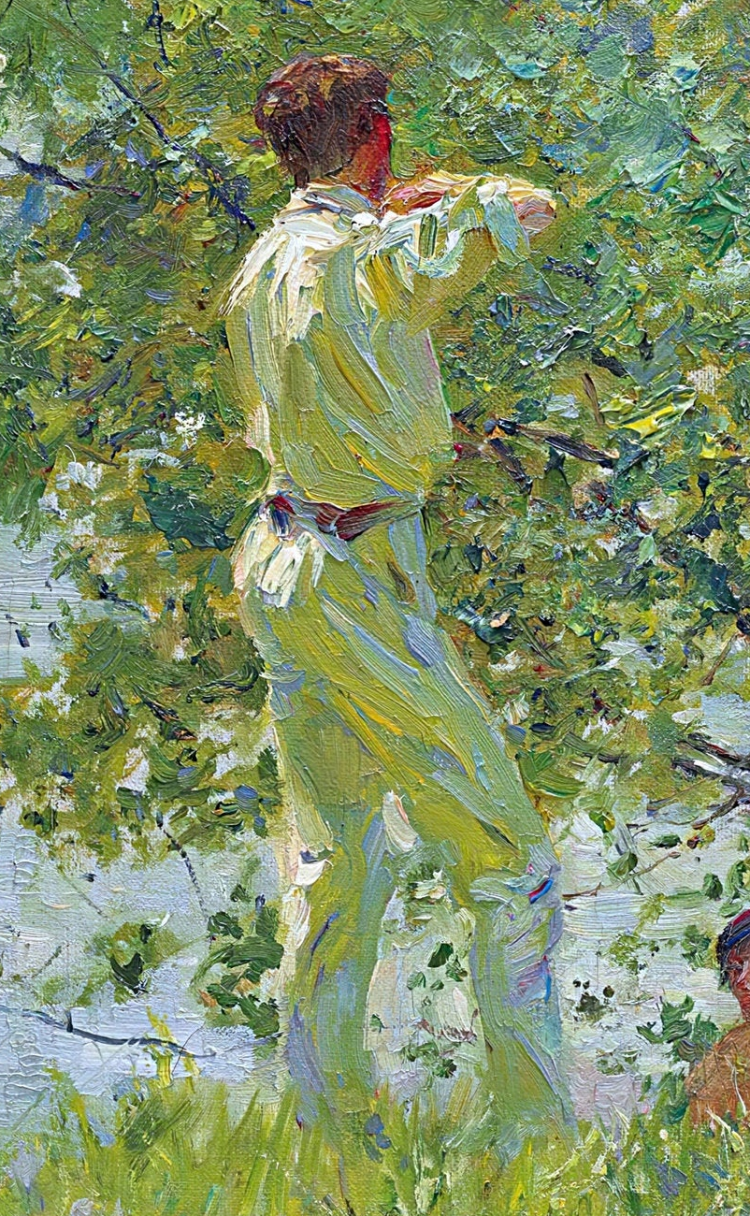 |
| Exhibited at the Royal Academy in the year of its completion, the painting measures seventeen by twenty-one-inches. |
Tuke is an icon of queer artists. The fact that his models were almost always adolescent boys makes him problematic to many, but has done nothing to make his work any less ubiquitous. The formula he most often employed, that he's remembered for: slim, white, naked youths posed gracefully by the seashore. On the sand, on a boat, in the water. Usually turned away for the viewer, usually quite discrete in their nudity. Almost always if full, golden sunlight. But even with all that natural light, the Impressionistic brushwork, they seem stagey to me, too posed. And to my way of thinking, though pretty, these paintings are just far too similar to sustain much interest. Once you've seen one....


But I just came across this painting, "Leafy June", and I think it's quite wonderful. Yes, we have the frolicking boys, but this feels completely natural and un-posed. The main figure in his cricket whites looks to be dressing after a swim, his companions clambering up the hill, preparing to do the same. The composition feels unplanned, the execution effortless. (I'm quite sure that that was never the case.) And the image and bold brushwork recalls Sargent in the way it so clearly captures a fleeting and precious moment.
*
A few other of Tuke's less beachy pieces.
 |
| Henry Allen in Cricketing Whites, 1903. |
 |
| Nicola Lucciani, circa 1913-14. |
 |
| Nicola Lucciani, circa 1913-14. The artist was devastated when Lucciani, a favorite model, was killed during WWI. |
 |
| A Woodland Bather, circa before 1893. |
 |
| The Lemon Tree, 1898. |
 |
| Half Length Study of a Boy, circa 1909. |
 |
| West Indian Boy (Samuel), watercolor, circa 1923-24 (dated 1926). |
I think this last piece is really lovely; what a pity that Tuke didn't strive for more diversity in his models. Adapted from Bonhams' catalogue notes:
Tuke went to the West Indies with the explorer Frederick Albert Mitchell Hedges and Lady Richmond Brown, an authoress and adventurer, accompanied by a Miss MacBeth the cousin of Dr. Gann a Mayan archaeologist who later joined them in Belize. They sailed from Avonmouth on 23 November on the S.S.Coranado. The first stop on the journey was Jamaica, which they reached in 15 days, and Tuke made several studies in oil and watercolour of the Black River where this painting was produced. There were many fishing expeditions with Hedges and Lady Brown, which required assistance from local people, including young lads who were employed to row the boats and make camp. Tuke used them as models for his paintings as he did back home in Falmouth.
Samuel (also called Samwell by Tuke) and Ralph were two of his most frequent models. They would go up the river in rowing or sailing boats and Tuke would find a beach or a mangrove swamp to paint them against. On one such expedition, they realised they had left Tuke's bag behind on the quay and when they returned it has been stolen with Tuke's watercolours in it. This was on 6th January 1924. It meant that although he was able to order more paints locally his palette of colours changed after this date and in particular he had to use a more acid viridian green than usual which is visible in the leaves of the tree in this painting. The model in this work is probably Samuel. This is because Tuke wrote in his diary for the trip about when he did most of his paintings and the models he used. He notes in his diary that he painted Samuel under a tree on two occasions once on 12th January, "In the boat on one of the nearer beaches and posed Samwell lying under the shadow of a tree by a shore, very difficult to start but eventually the figure came rather well", and on 19th January 1924 he noted, "Down to our old beach with Samuel under the trees, almost unpaintable with flickering shadows and not posing well". Tuke described Samuel as, "an interesting type. Looks like a fierce savage and is as gentle as a dove".















No comments:
Post a Comment